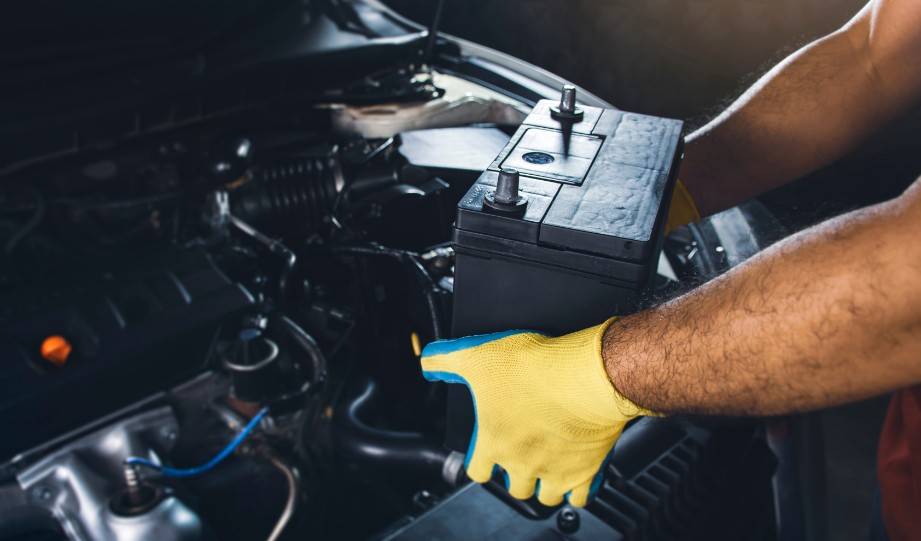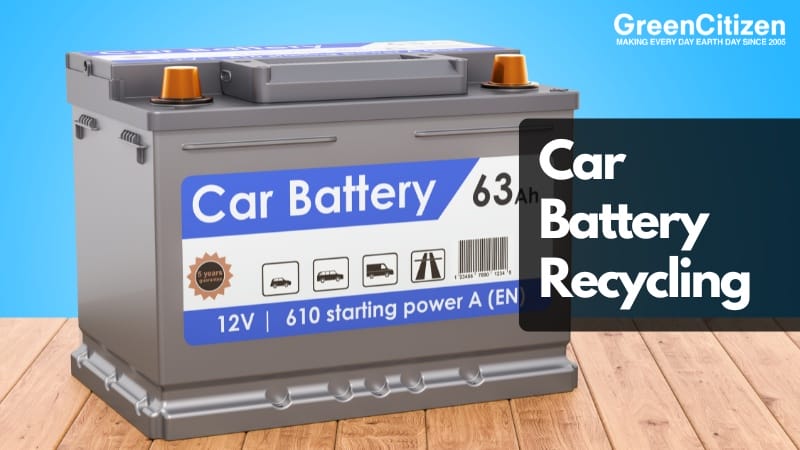Car battery recycling isn’t just eco-friendly—it’s required. Lead-acid batteries contain hazardous materials like lead and sulfuric acid, which can contaminate soil and water if tossed in the trash. That’s why federal and state laws mandate proper disposal through certified recyclers.
The good news? Recycling your old car battery is easy—and often free.
This guide breaks down how to recycle car batteries the right way, where to take them (including local options near you), and how to prepare them safely. Whether you’re clearing out a garage or replacing a dead battery, we’ve got you covered with safe, legal, and eco-conscious solutions.
Let’s dive into everything you need to know about car battery disposal and recycling—so you don’t just do it fast, you do it right.
Key Takeaway: Car Battery Recycling
Car batteries must never be thrown in the trash. They contain hazardous materials and are legally classified as household hazardous waste in many states. Recycle them through certified battery recycling centers, auto shops, scrap yards, or local hazardous waste programs. Use a battery recycling directory to find safe drop-off locations near you.
Note: GreenCitizen cannot currently accept any loose batteries not installed in electronics due to hazards associated with handling and storage.
How to Recycle Car Batteries Safely and Legally
Recycling a car battery starts with knowing your local options and understanding what’s accepted.
Whether you’re handling a standard lead-acid battery or a hybrid model, most automotive batteries can be safely recycled at drop-off locations near you.
The key is using certified recyclers and programs equipped to handle hazardous materials.
1. Drop It at a Certified Battery Recycling Center
Use a trusted resource like the Green Directory to find local car battery recyclers near you. Just enter your zip code and select “car battery.” Most centers handle lead-acid batteries, auto batteries, and even electric vehicle batteries.
2. Contact Your Local Hazardous Waste Facility
Municipal waste centers often run household hazardous waste (HHW) programs. Call ahead to confirm if they accept automotive batteries, and ask about drop-off days or collection events.
3. Return It to an Auto Parts Store
Major auto parts retailers like AutoZone, O’Reilly, and Advance Auto Parts accept old batteries for free—and may even give you store credit. This option is especially convenient if you’re buying a replacement battery.
4. Sell It to a Scrap Metal or Battery Recycler
Scrap yards and independent recyclers often buy spent car batteries for their lead and plastic casings. Search “car battery scrap buyer near me” or call local metal dealers.
5. Take It Back to the Retailer
In states with Extended Producer Responsibility (EPR) laws, retailers are legally required to accept old car batteries for recycling when you buy a new one.
6. Ask Your Mechanic to Handle It
Certified auto repair shops typically recycle the batteries they remove. If you’re getting a battery replaced professionally, ask if they partner with EPA-certified battery recycling programs.
7. Look for Local Battery Recycling Events
Many cities and counties organize free battery collection events for residents. These often include drop-off stations for car batteries, lithium-ion EV batteries, and more.
⚠️ Pro Tip: No matter which recycling option you choose, always call ahead. Some facilities only accept specific types of car batteries—like lead-acid or AGM—and may have drop-off restrictions. Confirming in advance ensures your trip doesn’t go to waste.
TL;DR: How and Where to Recycle Your Car Battery
You can recycle your car battery through certified recycling centers, auto parts stores, scrap yards, and hazardous waste facilities. Most major retailers and mechanics offer free battery take-back services, and many states legally require it. Use a battery recycling directory to find drop-off locations near you.
How to Prepare, Remove, and Transport a Car Battery for Recycling

Before recycling your car battery, it’s important to remove, store, and transport it properly.
Lead-acid batteries can leak hazardous materials like sulfuric acid if mishandled, and even a “dead” battery can still hold a charge. Follow these safety steps to avoid injury and ensure your battery arrives in recyclable condition.
Step 1: Remove the Car Battery Safely
- Wear gloves and safety glasses to protect against acid leaks.
- Turn off the vehicle and let the engine cool completely.
- Disconnect the negative terminal first, then the positive terminal.
- Use a wrench carefully—never touch both terminals at once.
- Remove any hold-down clamps securing the battery.
- Lift the battery out using both hands—it can weigh over 40 pounds.
Step 2: Store and Transport It Properly
- Inspect for cracks, leaks, or swelling—do not transport damaged batteries.
- Place the battery in a leak-proof plastic bag or secure battery container.
- Keep it upright at all times to avoid acid spills.
- Store away from heat, sparks, or flammable materials.
- Transport it directly to a certified car battery recycling location as soon as possible.
How Are Car Batteries Recycled at a Recycling Center?
Car batteries are recycled through a multi-step closed-loop process at certified facilities.
This includes neutralizing battery acid, separating plastic casings, and smelting lead components. These recovered materials—like polypropylene and pure lead—are reused in new batteries, reducing waste and the need for raw material extraction.
Step 1: Neutralize and Remove Battery Acid
Facilities begin by draining the remaining sulfuric acid from the battery. This electrolyte is then neutralized with industrial chemicals or converted into sodium sulfate for reuse in laundry detergents, textiles, or glass.
Step 2: Separate Plastic Components
The battery’s polypropylene casing and internal separators are removed and cleaned. These plastics are melted and molded into pellets for manufacturing new battery casings—creating a closed-loop system.
Step 3: Recover Valuable Metals
The lead plates and terminals are extracted and sent through a high-temperature smelting process. This process separates pure lead, which can be reused in new car batteries. Some facilities also recover trace metals like nickel or cobalt, especially from hybrid or EV batteries.
Step 4: Send Materials to Battery Manufacturers
The recycled lead and plastic are delivered to battery manufacturers. In many cases, up to 80% of a new car battery can be made from recycled materials—significantly reducing environmental impact and raw material demand.
Can You Throw Away Car Batteries? Here’s Why It’s a Bad—and Often Illegal—Idea
No, you should never throw car batteries in the trash.
Car batteries contain hazardous materials like lead and sulfuric acid, which are classified as toxic waste in most U.S. states. Improper disposal can contaminate soil and groundwater, posing serious risks to humans, pets, and wildlife.
If damaged or exposed to heat, car batteries can leak acid or even explode—causing fires in trash bins or landfills. Disposing of them improperly can also result in fines, as many states have laws that require proper battery recycling through certified programs.
Car batteries must be handled as household hazardous waste and recycled at approved drop-off locations.
How Are EV Batteries Recycled, and Why Is It Still a Challenge?
Yes, EV batteries are recyclable—but the process is complex, costly, and not yet sustainable at scale.
As millions of electric vehicles hit U.S. roads, recycling lithium-ion battery packs is becoming critical to reduce waste, recover valuable materials, and support a circular economy in the EV industry.
What’s Inside an EV Battery?
Electric vehicle batteries—like those in a Tesla Model S—contain modules made of lithium-ion cells. Each cell has:
- A graphite anode
- A cathode sheet (made of cobalt, nickel, manganese, or lithium)
- Electrolyte fluid and separators
Recyclers focus on the cathode sheet, where most of the battery’s value lies.
How Are EV Batteries Recycled?
Most lithium-ion EV batteries are recycled using two primary methods:
- Pyrometallurgy: Batteries are shredded and burned at high temperatures to recover metals like nickel and cobalt.
- Hydrometallurgy: Metals are dissolved in acid solutions and extracted through chemical processing.
These methods are effective but energy-intensive, generate secondary waste, and emit greenhouse gases—limiting their sustainability.
What Is Direct Recycling for EV Batteries?
Direct recycling is an emerging solution that preserves the structure of the cathode material.
By reusing the existing chemical structure, this method requires less processing, reduces emissions, and could dramatically cut the cost of producing new EV batteries. It’s still in early development but holds promise for scaling EV battery circularity.
In direct recycling, workers would first vacuum away the electrolyte and shred battery cells. Then, they would remove binders with heat or solvents, and use a flotation technique to separate anode and cathode materials. At this point, the cathode material resembles baby powder.
— Ian Morse, Journalist at ScienceMag.com
Frequently Asked Questions (FAQ)
Yes, AutoZone gives you money for old batteries in the form of gift cards and vouchers. It’s an easy way to make that trip for battery recycling worth your while.
Yes, some Walmart stores give you money for old batteries in the form of a core charge refund. Those are charges imposed when you bought the old battery, and it’s a key strategy of their battery recycling program.
Yes, O’Reilly Auto Parts gives you money for old batteries in the form of a $10 gift card. It’s a quick way to make some money on old car batteries.
Final Takeaway: Recycle Car Batteries the Right Way
Car batteries aren’t just heavy—they’re hazardous. Throwing them away is illegal in many states and puts people, animals, and water sources at risk.
The good news? You have multiple responsible options for car battery disposal—from certified recycling centers to auto parts stores and local hazardous waste programs.
To find the safest and closest drop-off near you, use the Green Directory, a free tool that connects you with approved car battery recycling services in your area.
Every battery you recycle helps protect the planet and keeps valuable materials out of landfills.

